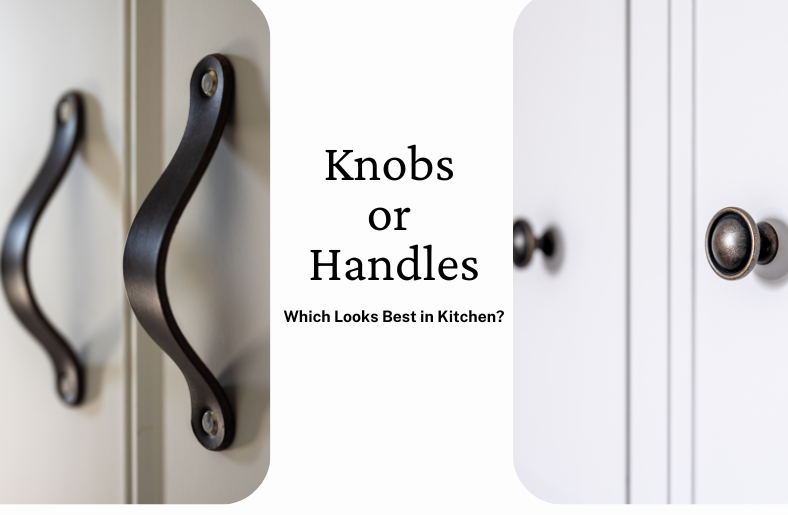If you are replacing your kitchen cabinets, you will surely have this question: knobs or handles? At first, it seems like a small choice. But once you start noticing the different shapes, finishes, and placements, it suddenly matters a lot more than you expected.
Here’s a simple, no-nonsense breakdown of how to choose between knobs and handles, what looks better, what works better, and what makes sense for your home.
What’s the Difference between a Knob and a handle?
Knobs are small and round (though they don’t have to be perfectly round). You usually install them with a single screw, and they’re most often seen on cabinet doors. Handles, also known as pulls or D-handles, are longer and are fixed with two screws. They offer a wider grip and are often used on drawers.
It’s not uncommon to mix both knobs on doors, handles on drawers, but it doesn’t always have to be that way.
Looks: What Works With Your Style?
Let’s start with looks. Because, let’s be honest, no matter how practical a choice is, you still want it to look good.
Knobs are subtle. If your cabinets have a shaker or traditional profile, knobs usually blend in better and feel more classic. They don’t take attention away from other kitchen elements. In smaller kitchens, they help keep the space feeling light and uncluttered.
Handles, on the other hand, add a more intentional, and we can say, a modern feel. They can make cabinets feel sharper and more structured. If you’ve got flat-front cabinetry, handles usually make more sense. They also offer more design impact if you’re trying to make a statement with your hardware.
What’s trending right now in Sydney and across Australia is a mix of both. Think slimline matte black handles on drawers with matching round knobs on top cupboards. It gives you that layered, balanced look without being too matchy-matchy.
Function: What’s Easier to Use?
This is where the choice starts to affect your everyday life. A good kitchen design isn’t just about how it looks; it’s about how it works.
Handles win when it comes to ease of use. Bigger surface area, easier to grab, especially when your hands are wet, greasy, or full. For heavier drawers (think pots and pans), handles make opening and closing way more comfortable. You don’t need to pinch or twist, just grab and pull.
Knobs, while fine for lighter doors or drawers, aren’t always as forgiving. If you’ve got arthritis or hand mobility issues, or if you’re just in a hurry, handles feel more practical.
Durability and Cleaning
You’ll be touching these things a lot. So, how do they hold up?
Handles are more stable because they’re fixed with two screws. That means less movement over time. You’re less likely to end up with a wobbly pull after a few months of opening the same drawer fifty times a day.
Knobs can become loose faster because they’re only fixed in one place. If you don’t tighten them regularly, they’ll start spinning. On the upside, they’re quicker to replace.
When it comes to cleaning, knobs are usually simpler. One wipe and you’re done. Handles can collect a bit more grime along the inner edge, especially in busier kitchens. If you’re a clean freak, knobs might feel easier to maintain.
Cost: Does One Cost More?
Generally, knobs are cheaper than handles. Less material, simpler installation, lower price tag. If you’re on a tight budget, going with all knobs can save you a decent amount.
Handles, especially long ones or high-end finishes like brushed brass or leather-wrapped steel, can cost more. And since they use two screws, installation can take a bit longer if you’re doing it yourself or paying a tradie.
That said, most homeowners today mix knobs and handles to balance the cost and function.
Safety and Kid-Friendliness
Got kids running around the kitchen?
Handles can sometimes stick out more depending on the design, and catch little heads or hips, especially in narrow walkways. Long handles can also become makeshift climbing bars for toddlers.
Knobs don’t stick out as much, so they’re usually a little safer in tight spaces. If you’re designing a family-friendly kitchen, this might be something to think about.
Placement Tips
This might sound like overkill, but correct placement makes a big difference.
- For knobs on cabinet doors, place them about 6 cm from the edge.
- For handles on drawers, centre them horizontally for smaller drawers. For deep drawers, you can place two smaller handles or one long one centred in the middle.
Make sure whatever you choose, you test it out. Open and close a few times. Imagine doing that every day for years. If it feels off, change it now, not after installation.
What Are Designers Choosing?
In most modern kitchen designs today, especially across Australia, you’ll see a mix of knobs and handles. It’s functional, affordable, and more visually interesting.
Designers tend to:
- Use knobs for upper cabinets and smaller drawers
- Use handles for lower cabinets and wide drawers
- Match finishes across all hardware (brushed nickel, matte black, antique brass)
- Choose handle shapes that match the kitchen’s overall vibe
If you’re working with a clean, Scandinavian-inspired design, slimline pulls work beautifully. For a farmhouse kitchen, aged brass knobs or cup pulls add warmth and charm.
So, Which One Should You Choose?
There is no right or wrong here. Depending on the use, you can choose the one that goes right for you. If you want use and durability, go with handles. In the same way, you can go with knobs if you prefer a better appearance.
As long as you go with premium quality handles, you are pretty much good to go.



